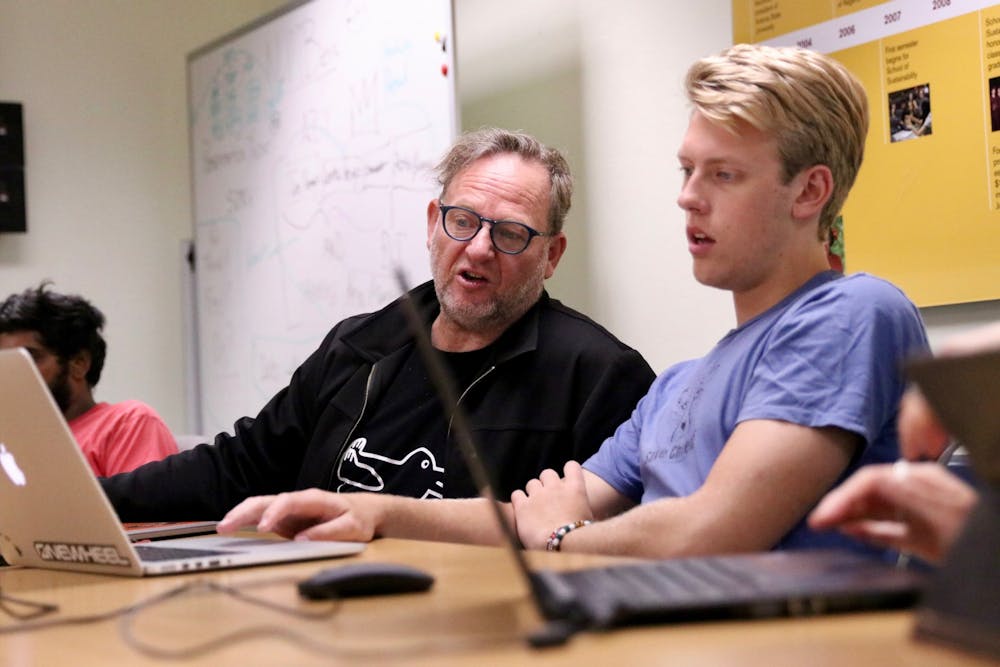The Acoustic Ecology Lab at ASU is using sounds to further progress in the understanding of climate change while also bettering people's quality of life.
The lab was founded in 2015 by co-directors Garth Paine, associate professor at the School of Arts, Media and Engineering and Sabine Feisst, School of Music professor.
According to Paine, acoustic ecology is the sound of the world around you.
The research involves the sounds of the environment and its impact on humans, the land and the animals that live there. Currently, their work is mainly based in the American Southwest, and particularly with the Joshua Tree National Park where they have a working relationship, Paine said.
Currently, the lab is working on a multitude of projects involving listening and the two biggest are The Listen(n) Project and the EcoRift project.
“We have two goals,” Paine said. “One is to engage the community through listening, by building stewardship and having some agency around the environments. People feel they can’t do much about climate change. We thought how do we help people engage with what is happening, this is something we do through field research and listening workshops.”
The other goal is to build a database that can help predict climate impact on our environments through sound, Paine added.
“Sounds gives you an immense amount of data,” Paine said. “Not just about what species are present but the health of the ecosystem itself.”
The Listen(N) Project involves recording the sounds of the environment and documenting them over the years through an online database accessible to anyone.
Sounds in the environment can track factors like temperature, humidity, and which animals are currently in the ecosystem.
The lab uses workshops to teach people how to do field recordings and add to the database, giving community residents a way to contribute to the awareness of the importance of nature, its sounds and the effects of climate change around them.
“If you take sound away from an ecosystem it isn’t an ecosystem,” Feisst said.
The lab does more than just record sounds, through their EcoRift project, the lab is using virtual reality to bring national parks to people who would be unable to attend.
This project is designed to allow those who are unable to visit national parks, due to physical conditions or from a lack of resources, to be able to be a part of a similar experience.
According to Paine, the arrival of virtual reality signaled to him an opportunity to bring the places he worked in every day to people who aren’t as fortunate.
“We currently have a version where you can select five locations (from the globe), where you can listen to the environment and have a 360-degree view," said Valarie Adams, a senior computer science and engineering student.
Right now, the lab is applying the technology further by working with the Watts College of Public Service and Community Solutions for Applied Behavioral Health Policy to bring this technology to patients in hospitals and nursing homes, as studies have shown that being in nature is beneficial to health and recovery, Paine said.
The lab has also done small studies on this topic in the past year and the results have been positive.
Documenting sounds from the environment and developing virtual-reality tools to help people experience nature are not the only things the lab does. It also currently has a variety of other projects with other purposes centered around sounds.
Right now, senior mechanical engineering student Cameron Carver is working with the lab and the Phoenix Zoo on using a gunshot detection algorithm to be used in Costa Rica to protect a reservation from potential poachers.
Along with the Listen(n) and EcoRift projects, Feisst is also working on promoting awareness for students with hearing loss at the School of Music through discussion and by using a new virtual reality experience to simulate the effects of impaired hearing.
“It’s like this elephant in the room at the School of Music,” Feisst said.
The lab hopes that the work will help continue to raise national awareness for the importance of sound while using it to better lives across the country.
“ ... It's good for us to share these ideas and to get people to think about listening and that the sounds of the environment are important," Paine said. "If that makes us conscious about that then we’re going to start making decisions that change the way we create sounds."
Reach the reporter at wmyskow@asu.edu and follow @wmyskow on Twitter.
Like The State Press on Facebook and follow @statepress on Twitter.

Wyatt Myskow is the project manager at The State Press, where he oversees enterprise stories for the publication. He also works at The Arizona Republic, where he covers the cities of Peoria and Surprise.




